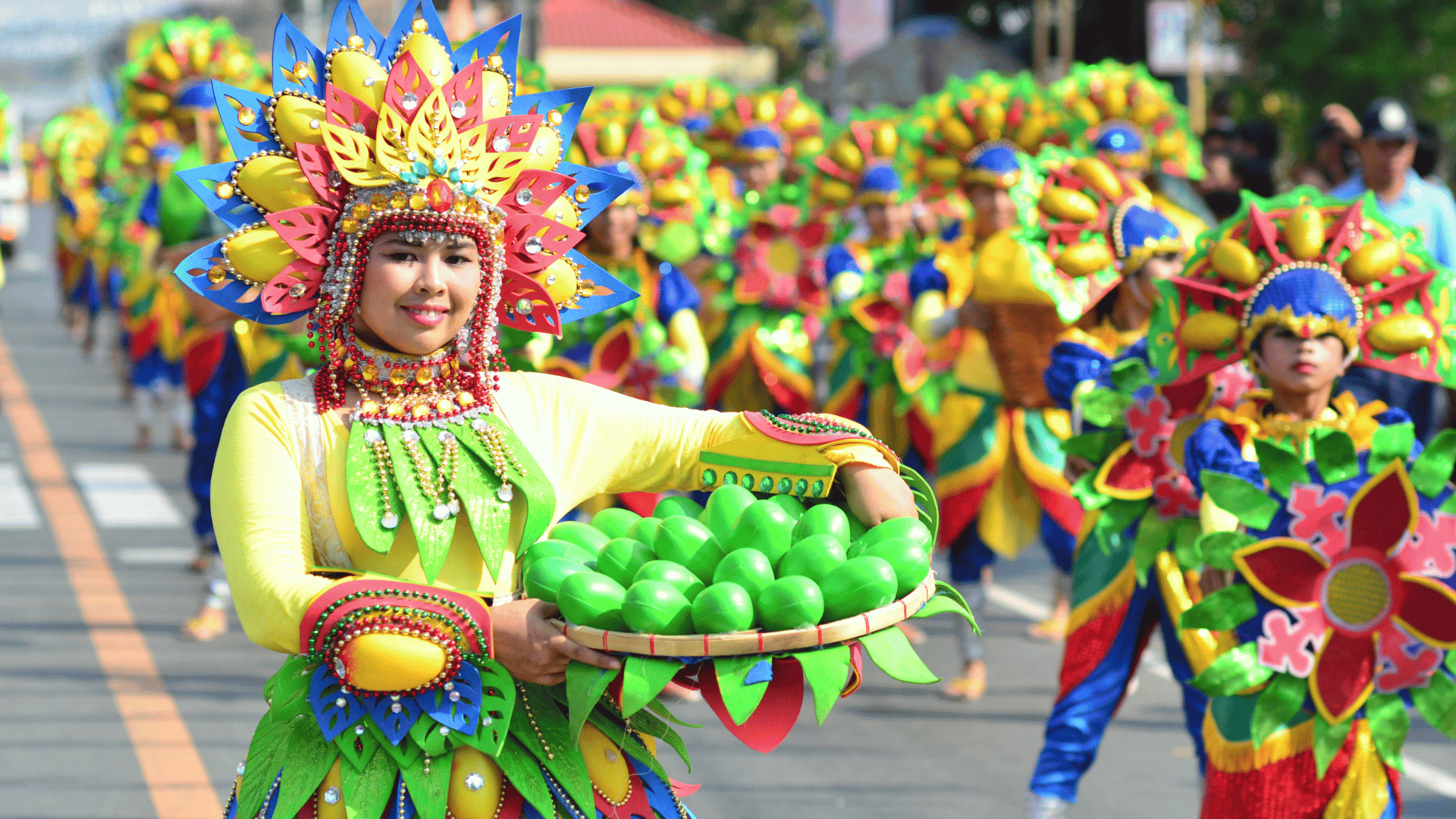The Philippines is renowned for its vibrant and diverse festivals, each showcasing unique traditions, activities, and cultural richness. Among the plethora of celebrations, 12 festivals stand out with their distinctive charm. The Sinulog Festival, held in Cebu City, captivates participants and spectators alike with its dynamic street dancing and grand parade, paying homage to Sto. Niño. Meanwhile, the Masskara Festival in Bacolod City is a riot of colors and smiles, featuring elaborate masks and lively dance competitions. The Pahiyas Festival in Lucban, Quezon, is a feast for the eyes, as houses are adorned with colorful decorations made from local produce, celebrating a bountiful harvest. The Ati-Atihan Festival in Kalibo, Aklan, showcases tribal dances and vibrant costumes, making it one of the country's oldest and most celebrated events. In Iloilo City, the Dinagyang Festival combines religious fervor with spectacular street performances. The Panagbenga Festival in Baguio City celebrates the beauty of flowers with its grand float parade, while the Kadayawan Festival in Davao City pays homage to the region's abundant harvest and indigenous cultures. The Giant Lantern Festival in San Fernando, Pampanga, illuminates the night sky with intricately designed lanterns, reflecting the local craftsmanship. As the country is predominantly Catholic, Holy Week in various cities is marked by solemn processions and reenactments of Christ's passion, adding a religious dimension to the festivities. These 12 festivals showcase the Philippines' rich cultural tapestry, inviting both locals and visitors to experience the joy, creativity, and spiritual significance embedded in these annual celebrations.
Celebrated cultural events to watch out for and attend as you plan out your year of travel
- Sinulog Festival, Cebu City
- Dinagyang Festival, Iloilo City
- Ati-Atihan Festival
- Giant Lantern Festival, City of Saint Fernando
- Dinagyang Festival
- Moriones Festival
- Masskara Festival
- Pahiyas Festival
- Kadayawan Festival
- Panagbenga, or Baguio Flower Festival, Luzon
- Pintados Festival
- Higantes Festival
- Giant Lantern Festival
The Most Famous Festivals in the Philippines
The most famous festivals in the Philippines offer a captivating festival experience that reflects the country's rich cultural heritage. From the lively street dancing of the Sinulog Festival in Cebu City to the vibrant and grand celebration of the Maskara Festival in Bacolod City, these events showcase the Filipino spirit. The Giant Lantern Festival in San Fernando, Pampanga, is a mesmerizing display of creativity and light, while the Dinagyang Festival in Iloilo City combines religious fervor with dynamic dance and costume competitions. In Baguio City, the Panagbenga Festival, known for its breathtaking street parades, celebrates the beauty of flowers. The Ati-Atihan Festival in Kalibo, Aklan, featuring tribal costumes and dance rituals, is another crowd-pleaser.
The festivals celebrated during Holy Week, such as the Moriones Festival in Marinduque, bring a mix of solemnity and spectacle. The Philippines, being a Christmas capital, sees festive street parties and vibrant costumes during the Christmas season. Bacolod City's Pintados Festival and Davao City's Kadayawan Festival showcase local culture through cultural events and grand celebrations. Whether it's the grandest festivals like the Sinulog or the colorful parades of the Panagbenga, these festivals in the Philippines pay tribute to tradition, cultural rituals, and the Filipino way of life.
The diversity of these festivals is further highlighted by unique events like San Isidro de Labrador in various locales, emphasizing the significance of patron saints. Trade fairs in different regions add an economic dimension, bringing together communities for commerce and cultural exchange. Notably, the Philippines' oldest festival, with its deep-rooted traditions, unfolds on the third Sunday of January—the Ati-Atihan Festival in Kalibo, Aklan. Local performers and communities engage in dance rituals, showcasing tribal costumes that embody the rich cultural tapestry of the country. The festivals collectively contribute to the summer capital's vibrant atmosphere, bringing a sense of unity and celebration. From street dancers to costume competitions, these events provide a platform for Filipinos to express their artistic flair and cultural pride.
The boat races and fluvial parades in Tacloban City stand out, symbolizing the connection of coastal communities with the bountiful harvest from the sea. In Baguio City, locals decorate streets and homes during the Baguio Flower Festival, creating a colorful spectacle that mirrors the beauty of the region. The Philippines' best festivals, including the grandest and most famous, are a testament to the nation's cultural richness, vibrant traditions, and the warmth of its people. Whether paying tribute during religious celebrations or rejoicing in the grandeur of a street dance competition, these festivals create lasting memories and embody the true essence of Filipino culture.
How many festivals are held in the Philippines?
The Philippines is a vibrant tapestry of cultural diversity, and this is vividly reflected in the multitude of festivals celebrated throughout the archipelago. While it is challenging to pinpoint an exact number due to the dynamic and localized nature of these events, the country boasts an extensive array of festivals that cater to various traditions, beliefs, and regional characteristics. From north to south, festivals punctuate the Philippine calendar, each offering a unique glimpse into the local culture, history, and spirituality.
Major cities such as Cebu, Iloilo, and Bacolod host renowned festivals like the Sinulog, Dinagyang, and Masskara, respectively, showcasing elaborate street dances, vibrant costumes, and exuberant celebrations. The Ati-Atihan Festival in Kalibo, Aklan, and the Panagbenga Festival in Baguio City are among the many that draw attention for their cultural significance and artistic expressions. Religious events like Holy Week, featuring processions and reenactments, are observed in several regions. The Philippines, predominantly Catholic, also commemorates Christmas and the Holy Infant during the Simbang Gabi and Sto. Niño festivals. Local communities celebrate harvest festivals such as Pahiyas in Lucban, Quezon, and Kadayawan in Davao City, expressing gratitude for bountiful harvests through colorful decorations and cultural performances.
The sheer diversity of festivals in the Philippines underscores the richness of its cultural heritage, making it challenging to quantify the exact number as new celebrations continue to emerge and existing ones evolve. However, what remains constant is the Filipinos' zest for life and their fervent dedication to preserving and sharing their unique traditions through these festive occasions.
Where are most festivals celebrated in the Philippines?
Festivals in the Philippines are celebrated with unparalleled enthusiasm and cultural flair, making the archipelago a haven for those seeking a rich festival experience. From the lively dance and costume competition of the Sinulog Festival in Cebu City to the visually stunning Pahiyas Festival in Lucban, Quezon, where houses are adorned with vibrant decorations in honor of the patron saint, the diversity of celebrations is remarkable. The Masskara Festival in Bacolod City and the Dinagyang Festival in Iloilo City boast grand dance and costume competitions, while the Giant Lantern Festival in San Fernando, Pampanga, illuminates the night with intricately designed lanterns. Cebu City's Sinulog Festival and Bacolod City's Masskara Festival are among the most famous festivals, attracting visitors with their vibrant street parties and competitions. Baguio City, known for the Baguio Flower Festival, adds a touch of natural beauty to the festivities. The cultural richness extends to religious events like Holy Week, marked by solemn processions and rituals in various cities. Overall, the Philippines showcases a grand tapestry of festivals, each celebrating its own unique traditions and contributing to the country's colorful cultural mosaic.










